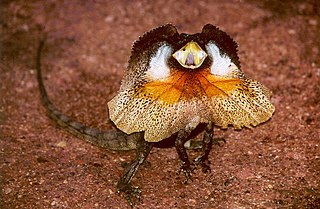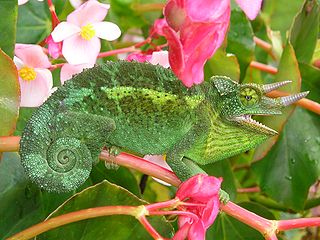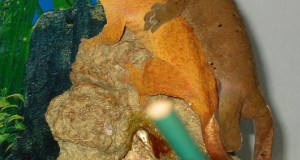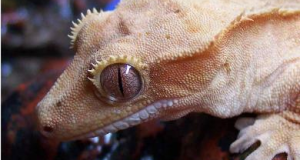From minute House Geckos to massive Water Monitors and endangered Rhinoceros Iguanas, an amazing array of fascinating lizards is now available in the pet trade. Fortunately, many are being bred in captivity, and new discoveries concerning their needs occur regularly. But the range of choices of pet lizards can be overwhelming. Not all species are suited for each keeper, and some, although popular, are best avoided by private collectors.
Drawing from decades of work with hundreds of species at the Bronx and Staten Island Zoos, today I’d like to highlight the pros and cons of some popular lizards. Detailed care information can be found in the linked articles, or by posting your questions below. Scores of other species could be used in place of those I have suggested…please be sure to write in with your own favorites, so that other readers may benefit from your experiences.
Chuckwalla (Sauromalus obesus)
This stocky desert-dweller was once difficult to maintain in captivity, mainly because its UVB requirements were ignored. Today’s high-output florescent UVB and mercury vapor bulbs have changed this situation, and captive bred animals are now readily available.
Exceeded in size among US lizards only by the Gila Monster, the Chuckwalla is calm in demeanor, and takes readily to hand-feeding. The largely herbivorous diet is a plus to many reptile keepers, and their enthusiasm at mealtimes is somewhat comical! Chuckwalla Care and Natural History
Chameleons (Family Chamaeleonidae)
Possessed of a tongue that may exceed the body’s length, mobile eyes, a “swaying”, leaf-mimicking walk, grasping “hands”, a prehensile tail and color-changing abilities, chameleons have fascinated people for centuries. But they are, in some ways, “too bizarre for their own good”. Well-intentioned fans often plunge into chameleon care without adequate preparation.
While the Veiled Chameleon and a few others are more resilient than most, none are easy to provide for. Their needs for specific environments, huge enclosures and highly-varied diets are difficult for many hobbyists to meet. And, despite misleading YouTube videos, chameleons are best considered animals to observe, not pets to handle (they abhor human contact!). Chameleon Care
Bearded Dragon (Pogona vitticeps)
Now such a common pet that it is sometimes “taken for granted”, the Bearded Dragon is actually a fascinating beast that has recently been found to produce mild venom (don’t worry…it is harmless to people) You may also be surprised to learn that it was virtually unknown in the USA, even in zoos, when I was a young, aspiring herpetologist…and that all US pet trade animals originated from a group smuggled out of Australia in the early 1980’s!
Unlike many lizards, the Bearded Dragon tolerates handling well. Those who can meet its needs for very high temperatures and UVB exposure can ask for no finer lizard pet. Bearded Dragon Care & Natural History
Frilled Dragon (Chlamydosaurus kingii)
Like chameleons, Frilled Dragons are so spectacular that they are sometimes purchased without sufficient forethought. However, males can exceed 3 feet in length, and neither they nor females take well to cramped quarters. Their hunting strategy – leaping to the ground from arboreal perches to chase insects – makes cage height an especially important consideration. An adult requires an enclosure measuring at least 3’ x 3’ x 4’ high. Otherwise, most of the Frilled Dragon’s needs can be easily met, and they are a most rewarding species with which to work. Frilled Dragon Care & Natural History
Leopard Gecko (Eublepharis macularius)
This pet trade staple is sometimes sold as a “starter-lizard” that requires little more than heat and some vitamin-powdered crickets. Those kept in this manner will not achieve the 30+ year lifespans seen in well-cared for individuals.
But if any lizard can be described as an ideal pet, it is the sturdy Leopard Gecko. Unlike many favorites, they have no need for UVB exposure, readily accept canned invertebrates, and adjust well to simple, moderately-sized terrariums. Most accept gentle handling, and a spectacular array of “designer” colors and patterns has been produced by breeders. Leopard Gecko Care .
Uromastyx Lizards (Dabb Lizards, Mastigures, Spiny-Tailed Agamids
)
During my time at the Staten Island Zoo, the reptile house was stocked with a fascinating array of creatures, including a wide variety of venomous snakes, but a huge exhibit inhabited by 13 Mali Dabb Lizards often stole the show. “Bulldog-faced” and often beautifully-colored, lizards of the genus Uromastyx remain among the most sought-after of reptiles.
Unfortunately, while captive breeding is becoming more regular, wild-caught individuals still appear in the trade, and these adjust poorly to captivity. These demanding desert-dwellers are best left to experienced keepers. Please see this article for more on their unique dietary needs (many favor hard split-peas and bird seeds!) and heat/UVB requirements.
Green Anole (Anolis carolinensis)
A pet trade staple since the 1960′s, when they were sold as “chameleons”, Green Anoles are not as easy-to-keep as many retailers would have one believe. While we’ve come a long way from when they were thought to thrive on sugar water and “turtle food” (ant pupae), many new keepers still misunderstand their needs.
Green Anoles are prone to stress-related ailments, and should not be handled unnecessarily. Although small in size, they are very active…a trio should be provided with a well-planted, 20 gallon aquarium. Without careful attention to their specific dietary, light, temperature, and humidity requirements, Green Anoles will not thrive. But when properly kept, a small group will exhibit a wide range of fascinating social interactions, and may even reproduce. Please see this 4-part article for more on their care and natural history.
 That Reptile Blog – Reptile, Amphibian and Exotic Pet Care and Information
That Reptile Blog – Reptile, Amphibian and Exotic Pet Care and Information







For first time owners I would have to recommend blue tongued skinks (to me they’re like bearded dragons only cooler) and leopard geckos (one of my first lizards). My favorite species to keep would be monitors and my hardest species to maintain would be the anoles surprisingly.
Thanks for the feedback, Alex. I agree about anoles…greens need a good deal of attention to detail, and other species can be quite delicate. here’s a 4 part article on green anoles that you may enjoy. Best, Frank
I would second blue tongue skinks. I’ve found them to have the best work:enjoyment ratio of any lizard I’ve worked with so far, with Rhacodactylus geckos being a close second. I think they are hard to beat in this regard. They get fairly large, but not so large that they are unwieldy or require huge enclosures, are very tolerant of being handled, and due to being omnivores have quite easy requirements. I think it is rare that they’ve been worked with long enough by a few folk who’ve figured out an excellent standard diet for them…animals being kept for over 20years on nothing more than canned dog food with cal/vit supplement added and some frozen vegetables mixed in. Also they have been found to do just fine cared for similar to snakes(provided a simple temperature gradient, UV or bright light not necessary). The whole giving live birth is quite a neat experience. I did miss incubating eggs but the babies are cute enough simply appearing in the cage one day. I doubt they will ever be abundant and popular as bearded dragons or chameleons in part due to slow reproduction and odd appearance but I think they will always have a place in my collection.
~Joseph
Thanks, Joseph…they are perfect in many regards; deserve an article, I’ll put it on list, hope all is well, Frank
It seems the chuckwalla and frilled lizard photos are switched. That could be confusing for some.
Thanks…I’m not great at setting up photos, will look into switching, best, Frank